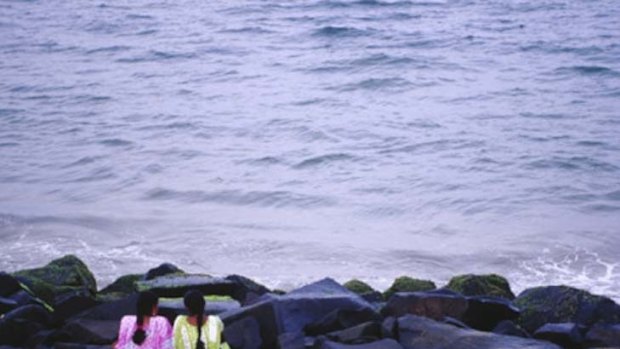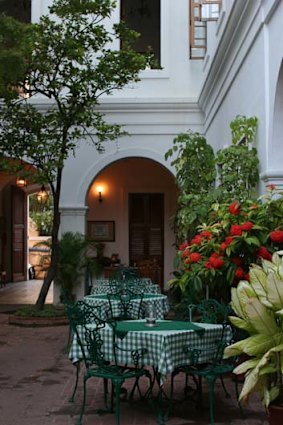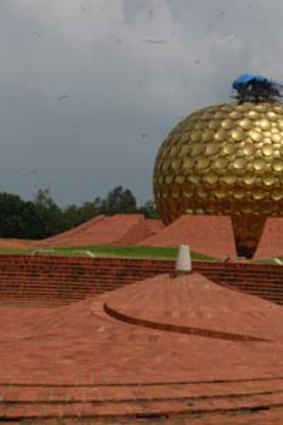This was published 12 years ago
India, with an accent
Pondicherry is marrying its French-influenced past with bold eco-tourism ventures to become a chic city-stay on the sub-continent's south coast, writes Leisa Tyler.

On golden Pondy ... women rest on the rocks at Pondicherry's City Beach.Credit: Getty Images.
EFFORTLESSLY laid-back, Pondicherry has the peculiar designation of being one of India’s most tranquil cities. Established as the headquarters of the French East India Company in 1674 and awash with salmon-pink-coloured mansions and grand, sunflower-yellow cathedrals framed by splays of hot-pink bougainvillea, the city seems a world away from its south Indian locale. This is a place of bicycles, boulevards, bouillabaisse and boule, where policemen wear red kepis and French is still the official language.
Actually, in Pondicherry sometimes you could be forgiven for thinking you weren’t in India at all.
Despite its Francophile charms, the French never had much luck with Pondicherry, or India for that matter. A few years after they established the tiny colony on the roaring Coromandel Coast, south of Chennai, the Dutch seized it. Later, back in French hands, the British then reduced the colony to ashes as an act of revenge against the French for coaxing the nawab – or prince – of Bengal to attack Calcutta, at that time the capital of the major colonial force on the subcontinent, British India.
The British also had to give Pondicherry back, as they did every other time fighting between the European neighbours erupted.
But in French hands, Puducherry, as it was renamed in 2006 (yet still remains better known as Pondicherry, or more affectionately just Pondy), was nurtured into one of south Asia’s most endearing cities.
For years the city’s biggest claim to fame was Auroville, an 800-hectare commune outside Pondicherry, founded decades ago by the late Paris-born mystic Mirra Alfassa – known to her disciples as The Mother. Alfassa also established half a dozen ashrams in Pondy, which, despite rigid curfews and stringent rules, including no meat or alcohol, drew a generation of spirituality-seeking travellers.

The Hotel Dupleix in Pondicherry.Credit: Getty Images
Now Pondy is upping its game and hoping to attract a new generation of tourists. Scrubbing and buffing its gorgeous collection of colonial-era mansions – all adorned with louvred shutters and cool, central courtyards – and converting them into boutique hotels, restaurants and shops, Pondy is reinventing itself as a design-savvy retreat on India’s south-east coast.
There is also a potent artisan movement re-emerging, with innovative individuals producing everything from hand-made paper to furniture and cheese.
The 16-room Hotel de L’Orient was Pondy’s first heritage hotel, opening in 2000. Restored by Neemrana, a Delhi-based hotel group, and under the guidance of the Indian National Trust for Art and Cultural Heritage (INTACH), the 1760s-built manor was restored and decorated with four- poster beds and wooden floors covered in rich Persian carpets. Things have waned a little since; the rooms are musty and the service is slow and dispirited. But the alternatives have since multiplied.

Auroville.Credit: Getty Images
The Hotel Dupleix, the former residence of the French governor-general, Joseph Francois Dupleix, is now a 14-room, white-washed oasis snuggling in a leafy courtyard where breakfasts of fresh croissants with home-made jam are served by friendly staff. A few streets away, the quaint Hotel du Parc has 10 tidy rooms, all with double french doors, clustered around a burnt-yellow-painted courtyard with a 100-year-old mango tree.
These properties are in Ville Blanche – ‘‘white town’’ – the leafy, mansion-peppered quarter where the French used to live and where most of Pondy’s heritage hotels are.
The Kerala-based hotel group, CGH Earth, renowned for creating venues sensitive to cultural and heritage roots, recently restored an old mansion in Pondicherry’s Ville Noir, the ‘‘black town’’ or Tamil quarter, which is distinctly more Indian in character and separated from Ville Blanche by a canal.
Built by a Chettiar family – a name given to mercantile bankers from central Tamil Nadu who made their riches ferrying teak and gemstones around Asia during the days of the British Raj – CGH Earth’s Maison Perumal is an elongated, two-storey mansion with 10 guest rooms built around two plant-filled courtyards. Painstakingly restored, with eggshell plaster walls, arched windows framing stained-glass panels and rusty-red stone floors, it gives travellers a rare glimpse into the lifestyle of Chettiar gentry.
I drop my bags in one of Maison Perumal’s old-world guest rooms and venture back out to the street, where, in predictable Indian fashion, auto-rickshaw drivers jostle and call, ‘‘Hello, Madam! Madam! Rickshaw, Madam?’’ Yet the best way to see Pondicherry is on foot.
Small and set out on a grid, Pondy fans out from a spacious esplanade whipped by a cool breeze from the Bay of Bengal.
Every evening families and tourists come here to promenade, stopping to snack at an impromptu market while children climb on the neighbouring Mahatma Ghandi statue.
I wander along the heritage trail, which takes in Pondy’s best monuments, and marvel at majestic, colonial-era administration buildings, the Notre Dame des Anges church, a miniature Arc de Triomphe and a statue of Joan of Arc.
Trinkets and home-grown crafts are to be found in the tiny boutiques lining Suffren Street, one of the best-preserved French-style streets in the town. CreArt hosts designer wares from Auroville – clothes, bedlinen and bags. Next door, Nirvana sells cool-kitsch pop-art bags, T-shirts and paraphernalia with Bollywood themes. A few doors along is an outlet of Fabindia, an organic-cotton homewares company. In the Tamil quarter, Casablanca sells herb-based toiletries and environmentally friendly bamboo-cloth clothes (be aware that the quality is low). Nearby is the flagship store of Hidesign, an Indian leather-handbag company that began in Auroville and recently sold shares to Louis Vuitton.
The next day, I visit the commune-turned-town of Auroville, a 10-kilometre drive inland from Pondy. With a population of 2200 spanning an array of ethnicities and religions, Auroville aims ‘‘to be a universal town where men and women from all countries will be able to live in peace and progressive harmony above all creeds, all politics and all nationalities’’.
I have never really warmed to Auroville, finding its followers a bit cliquey and unwelcoming (Aurovilleans are adamant the commune is not a tourist attraction). But it’s difficult not to be impressed by its visitors’ centre (the only place where outsiders can wander freely), which outlines the commune’s goals for renewable energy and self-sufficiency, including establishing solar farms in sun-drenched TamilNadu.
Dimitri Klein was also lured by the utopian promises of Auroville. The French native arrived in Pondicherry in 1997 but left after four years to open the Hotel Dupleix with Hidesign founder Dilip Kapur. Klein’s second venture was Elephant Valley, a 40-hectare organic farm–cum–eco-lodge on an abandoned tea plantation in the Palni Hills of the Western Ghats.
But it is at Klein’s third hotel, the Dune at Keelputhupet, 12kilometres north of Pondy, that he has really started to set new standards for ecotourism in India.
Rustic and more than a little eccentric, the 50-room property has been pieced together from recycled building materials.
Individually designed and arrayed in no discernible order, some villas are built entirely of bamboo; others feature walls of mud or brick; while a few have no walls at all. The Tower House occupies the tank of an old water tower. The Nawabi House, a stilted bungalow designed by Chennai fashion photographer Monica Gurdhe, would make an intimate roost were it not for the lack of walls. And while the Pop House is a whimsical homage to Tamil cinema, you need to be an ardent film buff to appreciate its garish decor.
Showers are solar heated, all airconditioners are reverse cycle, plastic is banned, foodstuff is farmed locally and organically and the hotel self-funds an on-site school in cottage industries for disadvantaged teenagers. The service is relaxed and attentive, there are two restaurants serving organic and macrobiotic food, access to the beach is direct and there is a fully fledged spa with a watsu pool, while a healer and ayurvedic doctor oversee a range of programs. To add to the amiable atmosphere, a bunch of friendly ducks and dogs wander the 14-hectare property cosying up to guests. It all makes the Dune a fabulously tranquil place to stay.
Back in Pondicherry, I head to Satsanga restaurant for dinner. Opened under the eaves of a colonial mansion, the diner has wicker chairs, slow-whirling fans and dubious service (‘‘Yes, what do you want?’’ asks the waiter when my dinner partner and I walk in), as well as what most guidebooks describe as Pondy’s best French food.
The menu includes duck pate with crunchy baguette and coq au vin – dishes that sound particularly enticing after several weeks in curry-heavy India – and it’s all tasty but I can’t help but notice an overriding scent of masala.
For me, Satsanga’s food sums up Pondy perfectly: French accents but with an inescapable Indian air.
Three other things to do
1. Take a day trip to Tranquebar. Meaning "the place of the singing waves", this fishing village 100 kilometres south of Pondy was the headquarters of the Danish East India Company in the 17th century. Although its presence in India was limited, the Dansk Ostindisk Kompagni, together with the Swedish East India Company, smuggled more tea out of India and into Britain during their tenure than the British did. Take a stroll along Tranquebar's ramparts and potter through its museum, which brims with porcelain artefacts, Danish-era manuscripts and daggers, before stopping for a leisurely lunch at the Bungalow on the Beach (24 King Street, +91 4364 288 065), a 17th-century mansion recently restored and converted into a boutique hotel.
2. Drive an hour north of Pondicherry, past the salt farms, to the World Heritage site of Mahabalipuram. Part of the Pallavas, a 4th-9th century dynasty whose reign extended across southern India, Mahabalipuram's stone temples and rock carvings were profoundly influential on early temple design in Asia, forming the basis for religious sanctuaries from Bali to Cambodia. Go early to avoid the bus-loads of tourists, take in the bas reliefs of Arjuna's Penance, the 8th-century Shore Temple and cave temples, before having a seafood lunch at one of the cafes lining the beach.
3. Head to the Sri Manakula Vinayagar Temple, tucked down a back street south of Pondicherry's Sri Aurobindo Ashram, for a pat on the head from its resident elephant — considered to be good luck in India. On M.G. Road, the Varadaraja Perumal Temple is believed to be the oldest temple in the city, dating to 600AD. While there take a peek at the painted friezes and sculptured pillars, typical of Dravidian temple architecture, which emerged in south India thousands of years ago.
Trip notes
Getting there Singapore Airlines flies from Sydney to Chennai via Singapore, priced from $1409 (low season). 13 10 11, singaporeair.com. From Chennai, it takes about 2½ hours to drive to Pondicherry along the East Coast Road.
Staying there Maison Perumal, built in an old Chettiar mansion at 44 Perumal Koil Street, is near the main shopping area and has double rooms from 6000 rupees ($126.40), including breakfast. +91 484 301 1711, cghearth.com. The Dune has 50 ecologically sensitive rooms and suites flanking a roaring beach at Keelputhupet village, north of Pondicherry. Double rooms are from 5500 rupees, including breakfast. (+91) 413 265 5751, thedunehotel.com.
Shopping there CreArt, Fabindia and Nirvana are clustered together on Suffren Street in Ville Blanche. Casablanca, Hidesign and Kalki, which stock clothes and craft pieces, are in the main shopping area along Mission Street.
Before you go Australian citizens require a visa to travel to India. Allow at least six weeks for the process. Pondicherry is hot and humid year-round, however, temperatures soar to 40 degrees-plus from May to July. August to October is monsoonal, with daily downpours. November to April is the cool season and the peak period for tourists.
More information incredibleindia.org
The writer was a guest of CGH Earth
Sign up for the Traveller Deals newsletter
Get exclusive travel deals delivered straight to your inbox. Sign up now.